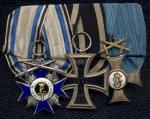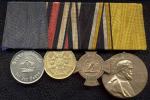-
Posts
4,908 -
Joined
-
Last visited
-
Days Won
97
Content Type
Profiles
Forums
Blogs
Gallery
Events
Store
Everything posted by Dave Danner
-
You have to remember that in the Prussian Army, Generalquartiermeister was not traditionally merely an admin/logistics officer. It was originally a wartime title, given to General Theophil von Podbielski in the Austro-Prussian War and again in the Franco-Prussian War, when he was the right-hand man to the Chief of the General Staff Helmuth von Moltke the Elder. Of course, most of Podbielski's responsibilities were administrative and the like, freeing up Moltke to focus on operational matters. After 1871, no one held the title until Alfred Graf Waldersee as the Elder Motlke's chief deputy from 1881 to 1888. When Graf Waldersee succeeded the Elder Moltke as Chief of the General Staff, no one held the title until 1896, when Franz Xaver von Oberhoffer became Generalquartiermeister. Oberhoffer remained Generalquartiermeister until his retirement in March 1902, when he was succeeded by Karl von Bülow. In January 1903, Bülow was named commander of III.Armeekorps, and there was again no Generalquartiermeister. Helmuth von Moltke the Younger received the title in 1904 as Alfred Graf von Schlieffen's chief deputy, and when he took over from Schlieffen in 1906, again there was no Generalquartiermeister. On mobilization, Hermann von Stein, the commander of the 41.Division and earlier one of Moltke's Oberquartiermeisters, got the title. Over the next few months, as the field army experienced various shake-ups, the holder of the title changed rapidly. War Minister von Falkenhayn took the title in September 1914, but also succeeded Moltke as Chief of the General Staff. A few weeks later, Werner von Voigts-Rhetz, who had been chief of staff to the Generalquartiermeister (Stein and then Falkenhayn), took over. After Voigts-Rhetz died of a heart attack in November, Adolf Wild von Hohenborn, earlier head of the General Army Department and deputy War Minister under Falkenhayn, got the job. In January 1915, Wild von Hohenborn succeeded Falkenhayn as War Minister. It doesn't appear that anyone held the title in the field after that, though Wild von Hohenborn apparently continued in the job, as the War Ministry ran most of these support functions. With the reorganization in 1916 when Hindenburg became Chief of the General Staff, it was thus natural for Ludendorff to take the title traditionally given to the principal deputy chief of the general staff, with the "1." to indicate he ranked ahead of Wild von Hohenborn. Viktor Hahndorff then got the Generalquartiermeister title. This mirrors somewhat the situation in the peacetime Army, when the Chief of the General Staff was assisted by several Oberquartiermeisters, with the senior one sometimes designated 1.Oberquartiermeister.
-
Hi David, I don't know if you still need information on these, but here are some of them: The commander of the 13. Inf.-Rgt wasn't Redern, but Roedern. Albert Karl Erdmann Ludwig Ernst Graf von Roedern, 23.7.1793-18.4.1861. Graf von Monts was Friedrich Wilhelm Karl Graf von Monts de Mazin, 24.12.1801-13.6.1886, later Gen.d.Inf.z.D. Your von Rheinbaben was a Baron/Freiherr von Rheinbaben, but I'm not sure which one. Regards, Dave
-
The Noguès in the Ivory Coast and the Noguès in Morocco and later general in World War II are not the same person. The later general was Auguste Paul Charles Albert Noguès. He was promoted to capitaine on 28 September 1910, and was a metropolitan artillery officer with the 13e Régiment d'Artillerie. He was attached to Lyautey's staff in 1912. The officer in the Ivory Coast was Henri François Eugène Noguès, a colonial infantry officer. He was promoted chef de bataillon on 9 May 1906 and in the 1910 Annuaire officiel des officiers de l'armée active was with the 1er tirailleurs sénégalais in the Ivory Coast. He was promoted to lieutenant-colonel on 24 September 1911, and went to the 24e RIC in Indochina. He appears to have stayed there. I don't have any wartime rank lists, but in the 1920-21 Annuaire, he was a général de brigade des troupes coloniales (date of rank 20 December 1917), and commander of the 2er brigade d'Indo-Chine. Best regards, Dave
-

EK 1870 When were the awards made?
Dave Danner replied to Chris Boonzaier's topic in Germany: All Eras: The Iron Cross
No clue about the percentage, but there are numerous announcements in the Militair-Wochenblatt in 1870 and 1871 of awards of the EK2, starting around 6 August 1870 with the award of the EK to the Crown Prince after the German victory in the Battle of Weißenburg. Typically, they weren't official announcements, but reports from various units of soldiers who had been decorated. For instance, the 22 October 1870 issue included a report from Grenadier-Regiment Nr. 11 of awards of the EK2 to Unteroffizier August Fenselau, Gefreiter Otto Hein, Hornist Wilhelm Hannig, Füsilier Ernst Horstmann and Füsilier August Riedel. In the 1870-71 rank list of the Prussian Army and Navy, which was published shortly after the war ended, most officers in various regiments seem to already have their EKs. I suppose many of these could have been awarded in victory ceremonies after the war ended, though. The Nachtrag, which was finalized on 1 October 1871, adds a bunch more awards, especially EK1s, for various officers. Here is an example page for the aforementioned GR 11: -
Should be identifiable, but still eludes me. Iron Cross 2nd Class, Bavarian Military Merit Order 4th Class with Swords, Saxe-Meiningen Honor Cross for Merit in War, Jubilee Medal of the Bavarian Army, Austrian Military Merit Cross 3rd Class with War Decoration, Bulgarian Military Merit Order on the ribbon of the Military Order "For Bravery". Tentatively identified to Lt.d.R. Ludwig Dürr of the 4th Bavarian Infantry Regiment "König Wilhelm von Württemberg". Iron Cross 2nd Class, Bavarian Military Merit Order 4th Class with Crown and Swords, Württemberg Friedrich Order Knight 2nd Class with Swords, Honor Cross for Combatants. Likely unidentifiable, but possibly also from 4.bay.IR, given the Württemberg connection.
-

Reischwehr pictures
Dave Danner replied to Marcin L's topic in Germany: Weimar Republic & Deutsche Freikorps
In the first picture, the officer in the middle appears to be from HR 17, since he is wearing a Husar uniform with a Totenkopf on his cap and the Braunschweig War Merit Cross 1st Class below his Iron Cross 1st Class. None of the others appear to be Braunschweigers - no Totenkopfs and no War Merit Crosses on those whose chests are visible. In the second picture, the artilleryman is wearing a medal bar with the Iron Cross 2nd Class, what appears to be the NCO's 15-year Dienstauszeichnung, and the Silesian Eagle 2nd Class. Below are the Iron Cross 1st Class and Silesian Eagle 1st Class. Maybe the uniform guys can add more details. In the third picture, medal bar is Iron Cross 2nd Class, Lübeck Hanseatic Cross, and Dienstauszeichnung. -
Pure Prussian precedence. All Prussian awards, including the Hannoverian, before any other state. Some more: 1870/71 KDM, Bavarian Cross for 1866, Centenary: Prussian D3, 1870/71 KDM, 1866 Königgrätz Cross, Centenary: Prussian General Honor Decoration, 1864 Düppeler Sturmkreuz, 1864 KDM, 1866 Königgrätz Cross, 1870/71 KDM,Centenary:
-

Slight shift in Central Africa?
Dave Danner replied to Chris Boonzaier's topic in Modern Campaigns and Conflicts
France currently has 950 troops in the RCA as part of Opération Epervier and 230 as part of Opération BOALI. There are also 450 in the Ivory Coast as part of Opération Licorne. That's out of a total of 4,750 on foreign operations. I don't think those numbers count troops stationed in Africa not as part of operations, such as the Eléments Français au Sénégal. This seems like a big drop - I recall a few years ago France had 15-20,000 troops overseas - but consistent with developments in most other Western nations, obviously including the US with the drops in troops in Iraq and Afghanistan. -
The precedence is actually correct for a World War II-era Wehrmacht service member. Lifesaving medals ranked after the Honor Cross for Combatants and the Austrian Commemorative Medal for the World War, and before Wehrmacht long service medals. Red Cross decorations ranked after Third Reich-era commemoratives like the "Flower Wars" medals here (and Olympic and Schutzwall decorations). And foreign decorations came last.
-
Actually, his draft registration says Czechoslovakia. Of course, Czechoslovakia did not exist when he was born. His detailed military record was probably destroyed in the fire in the National Personnel Records Center in 1973.
-
I wonder how the photo ended up in northern Hungary. I guess it could be anything from "he sent it to his family after the war" to "someone bought it on eBay".
-
-
Private George Kapusta Co. D., 10th US Infantry Regiment Camp Custer, Michigan George Kapusta was born on 17 February 1886 in the Austro-Hungarian Empire (in what later became Czechoslovakia) and died on 28 August 1962. He lived in Chicago, Illinois. He is buried in Resurrection Catholic Cemetery in Justice, Illinois. This was a mainly Polish cemetery, but the name Kapusta could be Czech, Slovak or Polish. He served from 2 May 1917 to 17 January 1919 in Company D, 10th Infantry. The 10th Infantry Regiment was sent Camp Custer, Michigan, in July 1918 when the 14th Division was being formed. World War I ended before the division went overseas. Regards
-
It was used until 1928. Here are some generals who rose up under Yuan Shikai and became warlords in the warlord era. I am not sure if there was a standard uniform throughout China, but these generals all came out of the north. They started out as officers of the Beiyang Army, a modernized Western-style army created in northern China in the late Qing Dynasty. If you look at some of the warlord pictures here: http://en.wikipedia.org/wiki/List_of_warlords_and_military_cliques_in_the_Warlord_Era you will see a number of uniform variations. With China's size and how fragmented the factions were, and with different Western nations jockeying for influence, there was no doubt a lack of uniformity in their uniforms.
-
That style of crescent and sun seems more North African to me. Algeria, Morocco, Mauritania or Tunisia. So maybe related to French colonial, and thus the Latin characters.
-
The date on the doc, 2. Oktober 1936, is the date all the initial awards were made to then-active servicemembers. So on that date you would have gotten all the classes to which you were entitled. Documents with later dates generally mean you either returned to active duty later, or reached the qualifying years of service later.
-
He was wounded as a Gefreiter in 3./IR 155 in fighting between 10 and 14 February 1915. He became a Lt.d.R. in IR 155 on 5 April 1916. He was injured in an accident in 1917, but 1917 Verlustlisten don't include units. His personnel file as a Lehrer in Essen says he was a Kriegsfreiwilliger on 1 August 1914 and served in IR 155 and IR 146, leaving service on 1 January 1919. He had the EK2, Ehrenkreuz für Frontkämpfer and presumably the Treuedienst-Ehrenzeichen 2.Klasse since he started teaching in 1911, military time counted for years of service, and he was still teaching as late as 1942, the last date for which I have any information on him.













